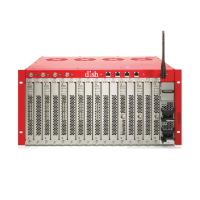8
CHAPTER 1 INTRODUCTION TO SMARTBOX
®
Thank you for purchasing a DISH SMARTBOX. SMARTBOX is a revolutionary centralized video distribution system
that can use both bulk and Dish QAM operational modes. SMARTBOX is much more than a commercial satellite
receiver—it is a highly integrated video distribution platform that operates in a 7/24/365 environment. Furthermore,
SMARTBOX is highly flexible and provides multiple operating modes that can be enabled simultaneously.
There are three functional concepts that are important to understand about SMARTBOX:
1. Signal Reception—SMARTBOX uses a single common set of assets to receive DISH satellite signals. The
satellite receiver blades then output TV channels or transponders to the backplane in the chassis for
distribution by one or more signal output blades. No output blade is required for IP distribution.
2. Signal Output—Multiple options for video output are available. These various output blades can be
configured in any combination because of the SMARTBOX architecture.
3. Operational Modes—All modes of operation in SMARTBOX are enabled via DISH feature-enabling codes.
Unlike other third-party devices that have been historically used with DISH receivers, the outputs for
SMARTBOX must be authorized by DISH or they will not function.
Site Requirements
All sites must provide the following:
1. One or more installed and “peaked” satellite dishes with low-noise-block-feeds (LNBFs).
Supported satellite orbitals:
• East Arc: 61.5, 72.7 and 77 degrees
• West Arc: 110, 119 and 129 degrees
• International: 118.7 degrees
NOTES:
• SMARTBOX allows the utilization of either Eastern or Western Arc orbitals with the optional addition of
the International orbital. Mixing Eastern and Western Arc orbitals is not allowed.
• Satellite at 121 degrees is not supported.
2. DISH 4-port high-capacity power inserter/surge protector (DN005050) and cables.
3. Nine inches of clearance above the SMARTBOX chassis for cooling airflow exhaust.
4. External terrestrial antennas installed and cabled to receive local channels for installations needing o-air
(ATSC) sources.
5. Internet connectivity via Ethernet cable and/or cellular modem connectivity via antenna mounted
on SMARTBOX.
6. 120V AC power for SMARTBOX power supplies and power inserters.
7. Ambient air temperature maintained around SMARTBOX between 0° and 50°C (32°–122°F) for
system cooling.
8. Non-condensing relative humidity around SMARTBOX between 5% to 95%.
9. Site plan/schema for mapping services and/or transponders to plant carrier frequencies.

